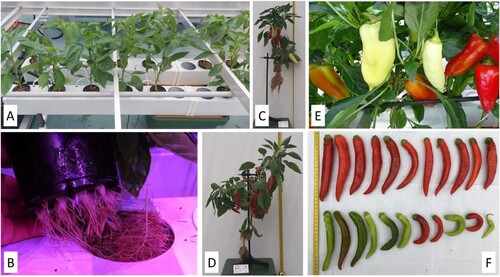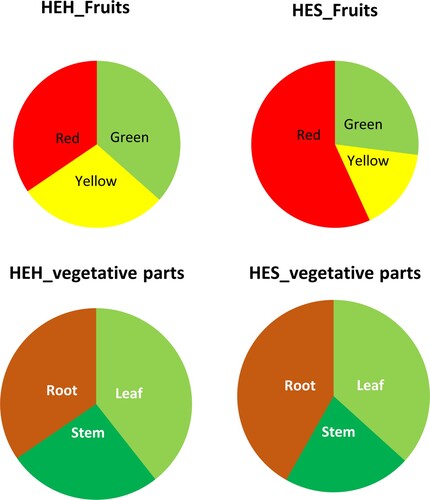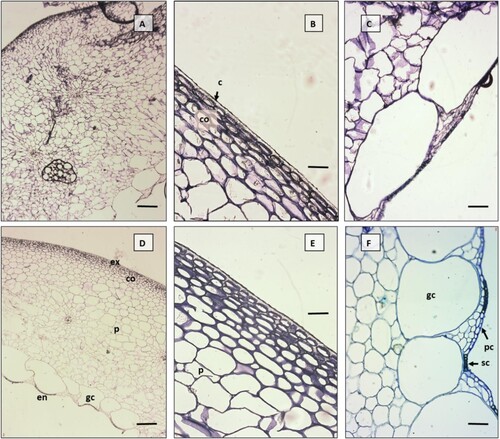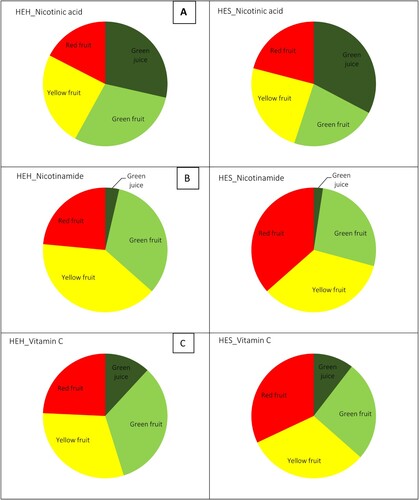Figures & data
Figure 1. Horizontally arranged GHE Aeroflow 10 hydroponic pepper cultivation system growing Hungarian Enigma Sweet (HES) pepper seedlings (A); Hydroponic-type root system of the 90-day-old Hungarian Enigma Sweet pepper complemented by WaterWick absorbent cord (B); 125-day-old Hungarian Enigma Sweet pepper plant showing the entire foliage and both, the substrate-type and the hydroponic-type root system (C); 125-day-old Hungarian Enigma Sweet pepper plant showing the entire foliage and both, the substrate-type and the hydroponic-type root system (D); Fruits of the Hungarian Enigma Sweet pepper at different maturity stage (E); Fruits of the Hungarian Enigma Hot (HEH) pepper at different maturity stage (F).

Table 1. Limit of detection (LOD) and limit of quantification (LOQ) values for polyphenols in green pepper.
Figure 2. Fresh weight (g/plant) of fruits (green, yellow, and red), leaves, stem, and roots of two green pepper varieties, i.e. Hungarian Enigma Hot (HEH) and Hungarian Enigma Sweet (HES). Different letters on the bars of the one parameter are significant according to the Tukey’s test (P ≤ 0.05). Data are Means ± SD and n = 10.

Figure 3. Fruit pericarp anatomy in two Capsicum annuum cultivars ‘Hungarian Enigma Sweet' (A,B,C) and ‘Hungarian Enigma Hot’ (D,E,F) based on light microscopy in transverse section. Pericarp transverse sections (A-D), Exocarp and collenchyma (hypodermis) (B-E), Giant cells and single layer endocarp (C-F). ex-exocarp, co-collenchyma, p-parenchyma, gc-giant cell, en-endocarp, pc-parenchymatic cells in endocarp, sc-schlerenchymatic cells in endocarp. Scale bars: A 500 μm, B 200 μm, C-D 50 μm, E-F 100 μm.

Table 2. Histological observations of fruits pericarp of two Capsicum annuum cultivars, i.e. Hungarian Enigma Sweet (HES) and Hungarian Enigma Hot (HEH).
Figure 4. Non-enzymatic antioxidant capacity in green juice and fruits (green, yellow, and red) of two pepper varieties, i.e. Hungarian Enigma Hot (HEH) and Hungarian Enigma Sweet (HES), (A) total polyphenol content (TPC); (B) total flavonoid content (TFC); (C) water-soluble antioxidant capacity (ACW); and (D) lipid-soluble antioxidant capacity (ACL). Different letters on the same bars are significant according to the Tukey’s test (P ≤ 0.05). Data are Means ± SD and n = 3.

Figure 5. Contents of: (a) nicotinic acid (µg/g), (b) nicotinamide (µg/g), and (c) vitamin C (mg/g) in green juice and fruits (green, yellow, and red) of two pepper varieties, i.e. Hungarian Enigma Hot (HEH) and Hungarian Enigma Sweet (HES), (A) nicotinic acid; (B) nicotinamide; and (C) vitamin C. Different letters on the same bars are significant according to the Tukey’s test (P ≤ 0.05). Data are Means ± SD and n = 3.

Table 3. Photosynthetic pigments (mg/g DW) in green juice and fruits (green, yellow, and red) of two pepper varieties, i.e. Hungarian Enigma Hot (HEH) and Hungarian Enigma Sweet (HES).
Table 4. Carotenoid speciation (mg/g DW) in fruits (green, yellow, and red) of two pepper varieties, i.e. Hungarian Enigma Hot (HEH) and Hungarian Enigma Sweet (HES).
Figure 6. (#A) Total nitrogen content; (B) total protein content; and (C) carbon content in green juice and fruits (green, yellow, and red) of two pepper varieties, i.e. Hungarian Enigma Hot (HEH) and Hungarian Enigma Sweet (HES). Different letters on the same bars are significant according to the Tukey’s test (P ≤ 0.05). Data are Means ± SD and n = 3.

Table 5. Tentative identificated phytochemicals of green pepper varieties.
Table 6. Concentrations of some nutritionally important phytochemicals (µg/g DW) detected in green juice and fruits (green, yellow, and red) of two pepper varieties, i.e. Hungarian Enigma Hot (HEH) and Hungarian Enigma Sweet (HES).
Table 7. Concentration of macro and microelements in green juice and fruits (green, yellow, and red) of two pepper varieties, i.e. Hungarian Enigma Hot (HEH) and Hungarian Enigma Sweet (HES).
